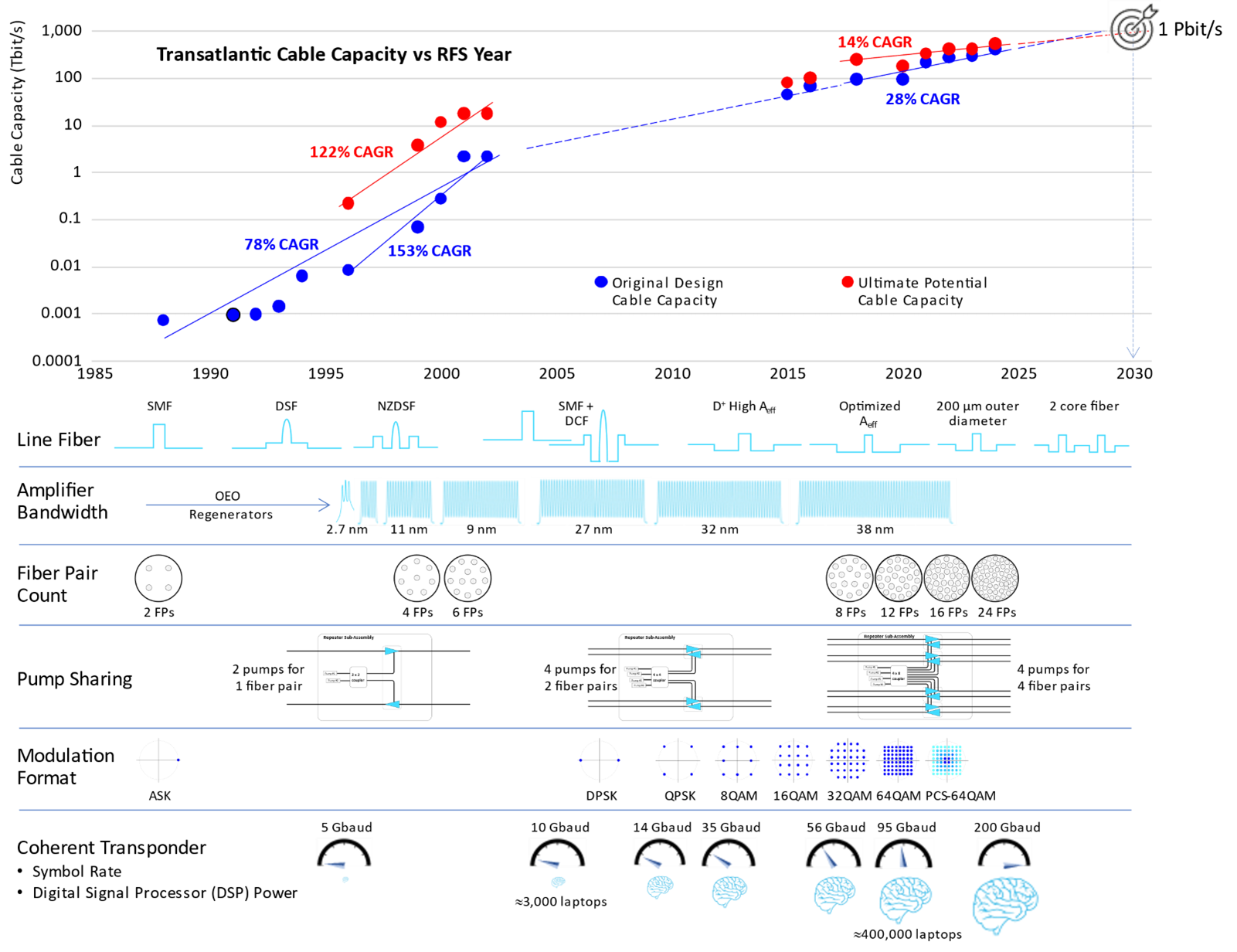In the last post, we reviewed the evolution of key technologies for increasing subsea cable capacity. In this installment, we will examine the introduction of new cable system technologies with the resulting evolution of the cross-sectional cable capacity. We will continue to use the trans-Atlantic route as a reference route, since the newest cable technologies for long-haul subsea transport have been traditionally introduced over this route, due to the strong pressure to minimize the cost per transported bit experienced by trans-Atlantic cable operators.
Trans-Atlantic Cable Technology and Capacity Timelines
In the Figure below, the subsea cable technology timeline has been slightly modified compared to the one included in the previous post. Unlike the trans-Pacific route, 8 fiber pair systems appeared only in 2018 (with the MAREA cable system) across the Atlantic Ocean (while Tata TGN-Pacific with 8 fiber pair cable was ready for service in 2002).

The top half of the figure above shows the evolution of the trans-Atlantic cable capacity. In the case of a ring architecture, with two physically separated cables between North America and Europe, we only considered the cross-sectional capacity of one cable. In the case of “Y” design (e.g., with one landing site in North America and two in Europe), we considered the capacity of the trunk cable between North America and the branching unit splitting the cable into two European branches. No cable systems were put in commercial service across the Atlantic Ocean between 2003 and 2014.
The blue circles represent the original design cross-sectional cable capacity for each trans-Atlantic systems represented (e.g., TAT-8 in 1988, TAT-12/13 in 1996, MAREA in 2019, and Anjana in 2024 – see here for a list of trans-Atlantic fiber optic cable systems).
Optically-amplified cable systems can be upgraded by plugging the most recent transmission equipment at their ends. The orange circles represent the estimated ultimate potential cable capacity, assuming future coherent transmission technology. For the post-2015 coherent cable systems, the next two or three generations of coherent transponder technology are expected to offer a maximum increase of up to 30% in capacity compared to current technology. All of the fiber optic cable systems put in commercial service before TAT-12/13 in 1996 were based on submerged optical-electrical-optical regenerators with no possibility for subsequent transmission bit rate increase.
Between TAT-8 (put in commercial service in 1988) and Apollo (2002, the last cable whose construction began before the 2000 dot-com bubble burst), the original design cable capacity grew at an impressive Compound Annual Growth Rate (CAGR) of 78%. The growth was even higher (at 153%) between the first optically-amplified trans-Atlantic cable system (TAT-12/13 in 1996) and Apollo. Introducing the new optical amplification technology under water, TAT-12/13 system designers were entering into new territories and over specified the cable design capacity to stay on the safe side. The resulting overengineering would allow a very significant capacity gain if this system were still in commercial service and upgraded with future coherent transmission equipment. This is illustrated by the large gap between blue and orange circles in 1996. This large gap can be still observed between 1999 to 2002, due to large system margins and low spectral efficiency in the original design of these cable systems.
Deployment of trans-Atlantic cable systems resumed in 2015 with EXA Express (aka Hibernia Express), promptly followed by AEC-1 in 2016. Between 2015 and 2024 (the date planned for the introduction to commercial service of the Anjana cable system), the original design cable capacity is growing with a CAGR of 28%. Assuming capacity upgrades will be made with future transponder technology, the ultimate potential cable capacity is planned to grow with a CAGR of 14% between 2018 (MAREA) and 2024 (Anjana). For the MAREA cable system, the current maximal cable capacity has already been doubled, compared to the original design capacity (28 Tbit/S vs 14 Tbit/s). This is due to the fact that MAREA was the first open cable system designed and specified across the Atlantic Ocean, with probable excess system margins considered. With accumulated experience in designing and specifying open cable systems, the original design capacity is more accurately determined with a minimal amount of system margin and considers the SLTE generation to be available at the RFS date. Therefore, this leaves less overhead for future capacity improvements.
The trendline for original design and potential ultimate cable capacity indicates that the industry may be able to put in commercial service a 1-Pbit/s (1015 bit/s) cable system across the Atlantic Ocean in 2030 at the earliest. This 1-Pbit/s figure must be compared with the design capacity of the 24 fiber pair Anjana cable (480 Tbit/s).
In our next post, we will review and discuss short-, mid-, and longer-term technical enhancements that can be identified today to reach and exceed this 1-Pbit/s cable capacity bar.
For comments or questions, please contact us at: [email protected].